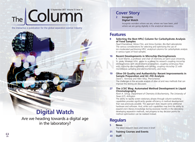The LCGC Blog: Automated Method Development in Liquid Chromatography
The ability to rapidly screen stationary phases through column-switching capabilities provides significantly greater efficiency in method development than was previously possible. The approach does require some additional hardware and software. And, while such capabilities may limit the ability to expand one’s literary knowledge during excessive months in the laboratory developing separation methods, real progress to key decision points for method optimization can be realized instead.
Photo Credit: sumkinn/Shutterstock.com

Kevin A. Schug, Department of Chemistry & Biochemistry, The University of Texas (UT), Arlington, USA
The ability to rapidly screen stationary phases through column-switching capabilities provides significantly greater efficiency in method development than was previously possible. The approach does require some additional hardware and software. And, while such capabilities may limit the ability to expand one’s literary knowledge during excessive months in the laboratory developing separation methods, real progress to key decision points for method optimization can be realized instead.
In my first summer of liquid chromatography (LC) experience in 1996, I sat in front of a newly acquired high performance liquid chromatography (HPLC) instrument at Virginia Tech working to optimize the separation of some analyte set, the details of which escape my memory. What I do remember is that over the course of that summer, I managed to read the entire The Lord of the Rings trilogy, primarily between injections on the instrument. Although we had a drawer of available HPLC columns in the McNair lab, they were predominately of the C18 variety. I sat and dutifully varied mobile-phase compositions until the desired separation was achieved. While I acknowledge I was a novice, and it was an excellent learning experience, especially after having just gone through my first American Chemical Society short course on HPLC, the process took quite a long time. Looking back and knowing what I do now, I probably would have approached this problem very differently.
Except, maybe it would have been impossible to approach that separation problem like I would now. I remember that one of the big advances in HPLC column technology that had happened back then, or at least not too long before I started my chromatography journey, was the move from irregularly shaped particles to those that were more spherical and uniform in nature. I can remember very clearly the slides from the short course showing micrographs of such particles. This advance vastly improved the quality of column packing, and subsequently the efficiency of separations. We had C18 columns from every different manufacturer at the time, but I certainly did not appreciate that one C18 could be very different than others. As I transitioned into my graduate schooling years (1998–2002), I was fortunate to take a full semester class on separations from McNair (and Prof. Larry Taylor). I remember discussions about selectivity-the best way to change selectivity is to change the stationary phase. The common thought experiment was to consider how different analytes might separate in the reversedâphase mode on a C18 phase versus on a cyano-bonded phase. As far as I can remember, there weren’t a heck of a lot of other choices-or at least they were less known to me at the time.
Nowadays, a plethora of different bonded chemistries is available. And these are not just bonded on the standard 5-µm silica particles of old, but rather to a wide range of fully porous, superficially porous, and different diameter particles. In addition to the standard C18 and cyano phases, we now have phenyl, biphenyl, fluorophenyl, diol, cholesterol, amide, polar-embedded C18, polymer C18, C8, C4, C30, and many other bonding chemistries we can consider for reversed-phase separations. Step outside of reversed phase, and the number of available chemistries continues to grow. It is both a chromatographer’s dream and a nightmare. Where do you start?
Quickly, astute chromatographers will assert that the name of the game is finding the right selectivity for separating their particular analytes. This means that it is likely more fruitful to spend time evaluating different stationary phases first, rather than spending a lot of time evaluating many different mobile phases. Such an approach can be good not only for finding the right column for an application, but also to gain a more fundamental understanding of the underlying separation mechanisms, as we have shown previously screening a series of hydrophilic interaction liquid chromatography (HILIC) phases for separation of estrogen metabolites (1). In that work, we still had to manually and systematically sit, connect, and evaluate the different columns. Thank goodness for graduate students!
More recently, we have had the opportunity to evaluate an automated method scouting platform through our collaborations with various companies. The system we have allows one to screen up to 96 combinations of mobile phases (using two quaternary pumps) and stationary phases (using a six-port column switching valve) with minimal operator attendance. It should be noted that many manufacturers offer similar solutions within their own platforms. In our case, we could simply designate the mobile- and stationaryâphase combinations of interest, and the software would automatically build the analysis sequence.
We first designed a multicomponent small-molecule analyte set having variable physicochemical properties from a range of compound classes of interest (for example, drugs of abuse, pharmaceuticals, metabolites, biomolecules, and so on). Admittedly, our goal was more of academic interest. We could very rapidly and systematically evaluate different stationary phases to explore their unique selectivities.
We began by first evaluating a series of four column chemistries offered as part of a method development tool kit (2). The column chemistries included a C18 phase having a polar unit close to the silica surface to allow for use of highâaqueous-content mobile phases, as well as polar-embedded C18-, biphenyl-, and fluorophenyl-bonded phases. The general idea was to provide a set of columns that could solve most challenging reversed-phase separation applications. We set up a generic scouting gradient and studied the retention and selectivity for the model analyte set. Clear advantages and disadvantages for different compound classes were quickly revealed with one or the other column. Practically, for any given application this would be a huge time saving for subsequent optimization of any given separation of interest. However, in our work, we were more interested in studying the different interactions that were invoked and demonstrating the simplicity of the screening platform for initial method development. Although the initial runs took some time to complete, there certainly was not enough time to read even a single novel from start to finish.
Based on the success and presentation of this work, we were approached by another column manufacturer to similarly evaluate a column line based on a new type of silica, type-C silica. This silica is prepared by converting silanol groups on type-B silica into silica hydrides. Of course, various bonding chemistries can also be evaluated, but in the final product, greater stability and less undesirable interactions with the solid support are purported based on this technology. We used the same analyte set to evaluate a series of four phases (cholesterol, bidentate-C18, diol, and Diamond Hydride) in a similar manner as before (3). Again, separations in the reversed-phase mode revealed interesting variations in retention and selectivity among the phases and analytes. Yet, an added benefit of this column set was the ability to also run separations in the aqueous normal phase mode (4). We further screened retention in this mode, which is operated very much like HILIC mode separations. A number of analytes showed dual-mode retention behaviour (notably, fentanyl was exemplary in its dual-mode retention nature), which can be advantageous for targeting different compound classes in a variety of different matrices.
In the academic laboratory, the availability of automated screening platforms provides unique opportunities for rapidly evaluating column retention and selectivity attributes. However, from a practical standpoint, such capabilities can be essential for rapidly developing real-world applications, especially as demonstrated recently by Grant for clinical applications requiring extremely stringent performance control (5). One can very comprehensively build means not only for optimizing selectivity, but also for evaluating matrix effects and improving throughput. In another relevant example, Zhang and colleagues demonstrated the use of column switching in the second dimension of a heartâcutting two-dimensional LC analysis for the determination of pharmaceutical impurities (6). Overall, the ability to rapidly screen stationary phases through columnâswitching capabilities provides significantly greater efficiency in method development than was previously possible. The approach does require some additional hardware and software. And, while such capabilities may limit the ability to expand one’s literary knowledge during excessive months in the laboratory developing separation methods, real progress to key decision points for method optimization can be realized instead.
On a somewhat related note, I would like to take this opportunity to congratulate Prof. Harold McNair on both being named a 2017 Fellow of the American Chemical Society, and also for his recent receipt of the 2017 Excellence Award by the North American Chemical Residues Workshop (NACRW). Both honours are absolutely well deserved. I am so humbled to have been one of the many people personally influenced and mentored by Prof. McNair. Thank you very much for all that you have done for chromatography and the people that practice it!
References
- H.P. Nguyen, S.H. Yang, J.G. Wigginton, J.W. Simpkins, and K.A. Schug, J. Sep. Sci. 33, 793–802 (2010).
- D.K. Appulage, E.H. Wang, F. Carroll, and K.A. Schug, J. Sep. Sci. 39, 1638–1647 (2016).
- D.K. Appulage and K.A. Schug, J. Chromatogr. A 1507, 115–123 (2017).
- J.J. Pesek, M.T. Matyska, R.I. Boysen, Y. Yang, and M.T.W. Hearn, Trends Anal. Chem.42, 64–72 (2013).
- R.P. Grant, Trends Anal. Chem. 84, 51–60 (2016).
- K. Zhang, Y. Li, M. Tsang, and N.P. Chetwyn, J. Sep. Sci.36, 2986–2992 (2013).
Kevin A. Schug is a Full Professor and Shimadzu Distinguished Professor of Analytical Chemistry in the Department of Chemistry & Biochemistry at The University of Texas (UT) at Arlington. He joined the faculty at UT Arlington in 2005 after completing a Ph.D. in Chemistry at Virginia Tech under the direction of Prof. Harold M. McNair and a post-doctoral fellowship at the University of Vienna under Prof. Wolfgang Lindner. Research in the Schug group spans fundamental and applied areas of separation science and mass spectrometry. Schug was named the LCGCEmerging Leader in Chromatography in 2009 and the 2012 American Chemical Society Division of Analytical Chemistry Young Investigator in Separation Science. He is a fellow of both the U.T. Arlington and U.T. System-Wide Academies of Distinguished Teachers.
E-mail:kschug@uta.eduWebsite: www chromatographyonline.com

The LCGC Blog: Historical (Analytical) Chemistry Landmarks
November 1st 2024The American Chemical Society’s National Historic Chemical Landmarks program highlights sites and people that are important to the field of chemistry. How are analytical chemistry and separation science recognized within this program?







